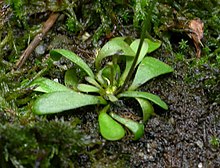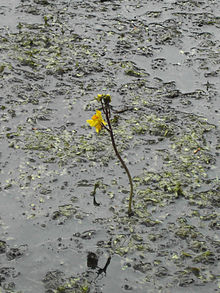Hose plants
| Hose plants | ||||||||||||
|---|---|---|---|---|---|---|---|---|---|---|---|---|

Flower of Utricularia longifolia |
||||||||||||
| Systematics | ||||||||||||
|
||||||||||||
| Scientific name | ||||||||||||
| Lentibulariaceae | ||||||||||||
| Rich. |
The water hose family (Lentibulariaceae) are a family of plants from the order of the mint family (Lamiales). The family includes approximately 350 species in three genera , all of which are carnivorous plants .
description
Vegetative habit
The species of the family are annual or perennial herbaceous plants, common are aquatic plants , some species are epiphytes . All species are carnivorous, thanks to special organs that differ depending on the genus, they are capable of catching and digesting small living beings. In addition to animals, their range of prey also includes protists , algae and pollen .
Some roots are missing (aquatic water hoses) or are greatly reduced (fatty herbs). The leaves are screwy, in down-to-earth rosettes or distributed along runners . They are often replaced by simple or multi-articulated stems that have been transformed into leaf-like structures and that are photosynthetically active. Leaf dimorphism or polymorphism is common.
Flower and fruit

The inflorescences are terminal or lateral, long-stalked, unbranched or weakly branched racemes , often there are also single flowers. Bracts are common, but can also be missing, they are usually greatly reduced along the inflorescence axis. At the approaches of the flower stalks there are often two prophylls , but they can also be more or less fused with the bracts.
The flowers are zygomorphic, five-fold and hermaphroditic, the calyx is divided into two, four or five parts or two-lipped, the tube is very short. The sepals are permanent and often not grown up to the base. The petals are fused and two-lipped and often yellow or purple. The simple or two-, four-, five- or six-lobed lower lip is usually provided with a raised, often two-part, and usually with an awl-shaped, cylindrical, conical or sack-shaped spur on the throat. The upper lip is simple or two-lobed, rarely multi-lobed.
There are two stamens anchored at the base of the crown , the stamens are linear, short and usually curved towards each other, rarely longer and kinked, occasionally straight. The dust bags attached to the stamens with their backs are elliptical, have two counters that bend up and more or less flow together, they open through a simple slit.
The pistil has two carpels . The uni-, round, oval or elliptical ovary is upper constant, the simple pen short to very short, rare miss him. The scar is double-lipped, with the upper lip usually smaller than the lower. The ovules are anatropic, slightly sunk into the placenta, and either basal or central. The capsule fruits, which open up in a valvate or a circle in front , usually contain numerous seeds, whereas the rare capsules that do not open at all contain individual seeds . These are usually very small, of extremely different shape, the seed coat is usually thin, spongy or cork-like, rarely mucus-forming, an endosperm is missing.
genetics

The family contains many species with very small genomes in the more highly developed genera fish trap traps and water hoses , including the three smallest genomes of all bedspreads :
- 63.4 Mbp Genlisea margaretae
- 63.6 Mbp Genlisea aurea
- 88.3 Mbp Utricularia gibba
- 135 Mbp Utricularia blanchetii
- 140 Mbp Utricularia parthenopipes
The chromosome sets have basic numbers between x = 7 and x = 12.
The mutation rates in the matK genes of the chloroplasts of the trap traps and water hoses are among the highest in cover-seeded plants.
distribution
Water hose plants are distributed worldwide from temperate to tropical zones, but individual species penetrate to the limits of subpolar areas (Greenland, North Siberian Lowlands , Alaska, Tierra del Fuego ). However, they avoid arid and semi-arid areas, so they are almost completely absent in North Africa, the Middle East, the Arabian Peninsula, large parts of Central Asia and the interior of Australia. They reach their highest biodiversity in tropical Central and South America, in Southeast Asia and in tropical Northern Australia.
Like all carnivorous plant species, water hose plants thrive in damp to wet locations, but deviating from these, they often also tolerate locations with relatively little light.
Systematics

The family includes three genera :
- Butterwort ( Pinguicula L. )
- Trap traps ( Genlisea A.St.-Hil. )
- Water hoses ( Utricularia L. )
Around 350 species are among them, including more than 220 water hoses, around 100 fatty herbs and a little more than 20 fish trap traps. The number of species is constantly growing due to new descriptions, especially in the case of the water hoses and the fatty herbs.
The monophyly of the family is as little controversial as its scope, the delimitation of the genera from one another and their phylogeny. The fatty herbs are considered to be the most primitive genus in evolutionary terms, trap traps and water hoses form a much more highly developed clade. The following cladogram illustrates the relationships between the genres:
|
|
|
||||||
|
|
|||||||
|
Butterwort ( Pinguicula ) |
|||||||
|
|
The relationships within the mint family, on the other hand, have so far been poorly understood, and the position of the water hose family in them is also not clear. It was repeatedly assumed that the closest relatives of the family were the chamois horn family (Martyniaceae) or the rainbow plants ( Byblis ); the Angiosperm Phylogeny Group even included the latter in the water hose family in 2003, a concept that did not catch on. More recent studies also consider a relationship with the trumpet tree family (Bignoniaceae), but none of these results are reliable.
Botanical history

The name Lentibularia, which means something like "small (water) lens" in German and indicates the similarity of the water hose species that live exclusively in Europe with the habitus of the duckweed ( Lemna ), was already in pre-Linneischen botany in use. In the entry of the Species Plantarum, Linné places the name as a synonym for the Utricularia and refers to the name in the Ordo Plantarum qvae sunt Flore Irregulari Monopetalo by August Quirinus Rivinus from 1690.
As early as 1754, Jean François Séguier used the name again and, according to the rules of the ICBN , is the first to describe it . The generic name is now out of use or synonymous with the water hoses, only in the family name first described by Louis Claude Marie Richard in 1808 it is still preserved.
In the 20th century, Peter Taylor (water hoses, trap traps), Elza Fromm-Trinta (trap traps, water hoses) and Siegfried Jost Casper (fatty herbs, water hoses) made important contributions to the knowledge of the family .
proof
- F. Kamienski: Lentibulariaceae . In: Heinrich Gustav Adolf Engler and Karl Anton Eugen Prantl (eds.): The natural plant families [...] IV. Part. 3. Department b. , 1895, pp. 108-123
- Robert E. Woodson, Jr., Robert W. Schery, Peter Taylor: Flora of Panama - Part IX - Family 176 - Lentibulariaceae . In: Annals of the Missouri Botanical Garden. Vol. 63, no. 3, 1976, p. 565
- Peter Taylor: Lentibulariaceae . In: Flora Zambesiaca , Vol. 8, Pt. 3, 1988, online
- Zhen-Yu Li: Lentibulariaceae . In: Flora of Taiwan , Vol. 4, 2nd Ed., 1998, p. 718, online
Individual evidence
Most of the information in this article has been taken from the sources given under references; the following sources are also cited:
- ↑ J. Greilhuber, T. Borsch, K. Müller, A. Worberg, S. Porembski, W. Barthlott: Smallest Angiosperm Genomes Found in Lentibulariaceae, with Chromosomes of Bacterial Size . In: Plant Biology, 2006; 8: 477-490
- ↑ a b K. Müller, T. Borsch, L. Legendre, S. Porembski, I. Theisen, W. Barthlott: Evolution Of Carnivory In Lamiales . In: Plant Biology, 2004; 6: 770-777
- ↑ KF Müller, T. Borsch, L. Legendre, S. Porembski, W. Barthlott: Recent Progress in Understanding the Evolution of Carnivorous Lentibulariaceae (Lamiales) . In: Plant Biology, 2006; 8: 748-757
- ↑ Helmut Genaust: Etymological dictionary of botanical plant names. 3rd, completely revised and expanded edition. Birkhäuser, Basel / Boston / Berlin 1996, ISBN 3-7643-2390-6 , p. 333.
- ↑ Carl von Linné: Species Plantarum , 1:18 Lars Salvius, Stockholm 1753